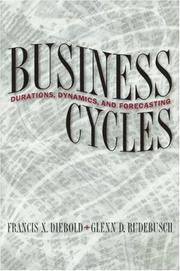| Listing 1 - 4 of 4 |
Sort by
|
Book
Year: 1991 Publisher: [S.l.] : [s.n.],
Abstract | Keywords | Export | Availability | Bookmark
 Loading...
Loading...Choose an application
- Reference Manager
- EndNote
- RefWorks (Direct export to RefWorks)
Book
ISBN: 9782406113522 9782406113539 Year: 2021 Publisher: Paris : Classiques Garnier,
Abstract | Keywords | Export | Availability | Bookmark
 Loading...
Loading...Choose an application
- Reference Manager
- EndNote
- RefWorks (Direct export to RefWorks)
Book
ISBN: 1788979931 9781788979931 9781788118996 9781788119009 1788118995 1788119002 Year: 2019 Publisher: Cheltenham Edward Elgar Publishing
Abstract | Keywords | Export | Availability | Bookmark
 Loading...
Loading...Choose an application
- Reference Manager
- EndNote
- RefWorks (Direct export to RefWorks)
Macroeconomics --- Blanchard, Olivier J. --- Blanchard, Olivier J., --- Blanchard, Olivier J., - 1948 --- -Macroeconomics

ISBN: 0691012180 Year: 1999 Publisher: Princeton, N.J. : Princeton University Press,
Abstract | Keywords | Export | Availability | Bookmark
 Loading...
Loading...Choose an application
- Reference Manager
- EndNote
- RefWorks (Direct export to RefWorks)
This is the most sophisticated and up-to-date econometric analysis of business cycles now available. Francis Diebold and Glenn Rudebusch have long been acknowledged as leading experts on business cycles. And here they present a highly integrative collection of their most important essays on the subject, along with a detailed introduction that draws together the book's principal themes and findings. Diebold and Rudebusch use the latest quantitative methods to address five principal questions about the measurement, modeling, and forecasting of business cycles. They ask whether business cycles have become more moderate in the postwar period, concluding that recessions have, in fact, been shorter and shallower. They consider whether economic expansions and contractions tend to die of "old age." Contrary to popular wisdom, they find little evidence that expansions become more fragile the longer they last, although they do find that contractions are increasingly likely to end as they age. The authors discuss the defining characteristics of business cycles, focusing on how economic variables move together and on the timing of the slow alternation between expansions and contractions. They explore the difficulties of distinguishing between long-term trends in the economy and cyclical fluctuations. And they examine how business cycles can be forecast, looking in particular at how to predict turning points in cycles, rather than merely the level of future economic activity. They show here that the index of leading economic indicators is a poor predictor of future economic activity, and consider what we can learn from other indicators, such as financial variables. Throughout, the authors make use of a variety of advanced econometric techniques, including nonparametric analysis, fractional integration, and regime-switching models. Business Cycles is crucial reading for policymakers, bankers, and business executives.
Prevision commerciale --- Cycles economiques --- Business forecasting --- Business cycles --- Methodes statistiques. --- Statistical methods. --- Andrews, Donald W. K. --- Balke, Nathan S. --- Blanchard, Olivier J. --- Brier, G. W. --- Burns, Arthur F. --- Campbell, John Y. --- Deaton, Angus. --- Diebold, Francis X. --- Eichenbaum, M. --- Filardo, Andrew J. --- Gordon, Robert J. --- Granger-Sims causality. --- Hamilton, James D. --- Kim, Chang-Jin. --- Mankiw, N. Gregory. --- Mitchell, Wesley C. --- Nelson, Charles R. --- Plosser, Charles I. --- Rudebusch, Glenn D. --- Savin, N. Eugene. --- Shapiro-Wilk test. --- Watson, Mark W. --- Wilcoxon test. --- business cycle: causes of. --- consumption. --- hazard function. --- linear models. --- mean-unbiased estimation. --- sequential probability rule (SPR). --- trends and unit roots. --- unit root tests. --- volatility: analysis. --- Statistical methods
| Listing 1 - 4 of 4 |
Sort by
|

 Search
Search Feedback
Feedback About
About Help
Help News
News